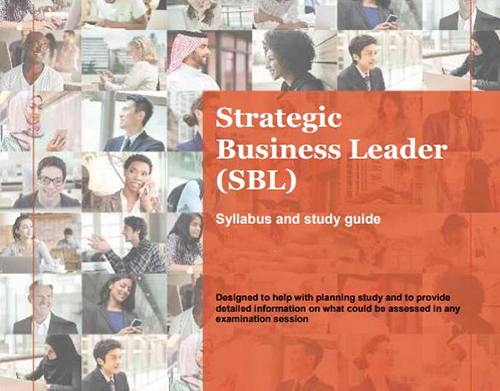SBL(P1+P3)技术文章下载
ACCA SBL 技术文章(2020年)
Leadership (A)
Culture and configuration
This article focuses on preparing and evaluating a cultural web of an organisation, and the importance of organisational structure and configuration.
Ethical decision making
This article looks at two of the main decision-making frameworks.
Governance (B)
All about stakeholders – part 1
Part 1 introduces the idea of stakeholders and stakeholding, and an explanation of the different ways in which stakeholders are categorised.
All about stakeholders – part 2
Part 2 then goes on to focus on stakeholders and stakeholding by looking at a number of different stakeholder groups
Corporate governance from the inside out
This article explains that effective corporate governance has both internal and external drivers. Although directors and managers of companies may have little influence over the external regulatory framework, they can and must play their part in ensuring effective internal governance and compliance from deep within their own organisations
Diversifying the board – a step towards better governance
Introduces the concept of board diversity and how it may benefit the organisation, followed by a discussion on the possible costs of board diversity. It concludes with a comment on the current regulatory initiatives of board diversity.
Independence as a concept in corporate governance
We explore the theory of independence, and discuss why it is vital in many contexts relating to corporate governance and professional behaviour.
Public sector governance
This topic is covered in section B6 of the Strategic Business Leader syllabus. The purpose of this article is to introduce this topic and give some pointers as to what the important themes are in terms of teaching and learning.
The integrated report framework
In 2013, the International Integrated Reporting Council (IIRC) released a framework for integrated reporting. The framework establishes principles and concepts that govern the overall content of an integrated report.
Strategy (C)
The strategic planning process – part 1
The strategic planning process – part 2
These articles focus on applying your knowledge of management and strategy to a scenario situation. Part 1 considers the complexities of strategic planning and how they can be broken down into three main areas. Part 2 adopts a similar simplification approach to the issues of strategic choice and strategic implementation.
Risk (D)
COSO’s enterprise risk management
This article examines the guidance published by the Committee of Sponsoring Organisations (COSO).
Strategic and operational risks
Examining the risks in terms of their potential impact and probability of occurrence
Technology and data analytics (E)
Cyber security and the strategic business leader
Syllabus area E4 of the SBL study guide requires students to discuss, assess and evaluate the security of IT systems. This article explains why these skills are crucial for those seeking to become effective strategic business leaders and demonstrates how they can be applied in practice.
Getting connected to the Internet of Things
The Internet of Things (IoT) is all about connections. The number of objects and devices being IoT-enabled by connected sensors, processors and transmitters has greatly increased.
Applying big data and data analytics in Strategic Business Leader
The article provides an overview of big data and what it is and its characteristics. It then explains data analytics and what types of analytics can be of most use to business leaders. The article will also look at some examples of how using big data and data analytics can improve business performance, focusing on aspects such as being sceptical about the use of data and, most importantly, how important it is to use data ethically, responsibly and securely to minimise reputational and financial risk
E-commerce
This article discusses business-to-business and business-to-consumer e-commerce and benefits for business, as well as the social and employment costs involved.
Organisational control and audit (F)
Internal audit
Internal audit – the control of controls – can feature as a key part of the corporate governance framework of an organisation, and can be viewed as a high level control in response to risk or by considering the detailed work required of internal audit.
Risk and environmental auditing
Risk auditing and social and environmental auditing are widely adopted and are increasingly being employed by organisations to increase investor confidence and respond to other stakeholder demands
Finance in planning and decision-making (G)
Performance appraisal
Performance appraisal requires good interpretation and a good understanding of what the information means in the context of the question.
Innovation, performance excellence and change management (H)
Blockchain: a revolution in the making
Blockchain is a term that many people have heard about, but very few still fully understand.
Cryptocurrencies and initial coin offerings (ICOs)
This article looks at what exactly cryptocurrencies are, the potential impact of this disruptive technology, and their application as a source of short and long-term finance.
Performance indicators
Both Strategic Business Leader and Advanced Performance Management exams require candidates to be able to establish key performance indicators and critical success factors.
ACCA SBL 技术文章(2019年)
All about stakeholders – part 1
All about stakeholders – part 2
Part 1 introduces the idea of stakeholders and stakeholding, and an explanation of the different ways in which stakeholders are categorised. Part 2 then goes on to focus on stakeholders and stakeholding by looking at a number of different stakeholder groups.
Big data
We define what exactly ‘big data’ is, how it can be used to inform and implement business strategy and examples of how it is being used by different industries today.
Corporate governance from the inside out
This article explains that effective corporate governance has both internal and external drivers. Although directors and managers of companies may have little influence over the external regulatory framework, they can and must play their part in ensuring effective internal governance and compliance from deep within their own organisations.
COSO’s enterprise risk management
This article examines the guidance published by the Committee of Sponsoring Organisations (COSO).
Culture and configuration
This article focuses on preparing and evaluating a cultural web of an organisation, and the importance of organisational structure and configuration.
Diversifying the board – a step towards better governance
Introduces the concept of board diversity and how it may benefit the organisation, followed by a discussion on the possible costs of board diversity. It concludes with a comment on the current regulatory initiatives of board diversity.
E-commerce
This article discusses business-to-business and business-to-consumer e-commerce and benefits for business, as well as the social and employment costs involved.
Ethical decision making
This article looks at two of the main decision-making frameworks.
Independence as a concept in corporate governance
We explore the theory of independence, and discuss why it is vital in many contexts relating to corporate governance and professional behaviour.
Internal audit
Internal audit – the control of controls – can feature as a key part of the corporate governance framework of an organisation, and can be viewed as a high level control in response to risk or by considering the detailed work required of internal audit.
Job design
This article focuses on how we might re-structure people’s jobs as a result of making a process more effective. The origins of the concept of job design – beginning with the work of Frederick Taylor in the early 20th century – through to the job redesign movement of the 1960s and 1970s are referenced. The article concludes with a brief consideration of the ethical issues that can arise from job design.
Organising transactions
Is transaction cost theory just simply a different lens through which agency theory may be observed and analysed? Are both theories trying to tackle the same problem: how do we persuade company management to pursue shareholders’ interests and company/shareholder profit maximisation rather than self-interest?
Performance appraisal
Performance appraisal requires good interpretation and a good understanding of what the information means in the context of the question.
Performance indicators
Both Strategic Business Leader and Advanced Performance Management exams require candidates to be able to establish key performance indicators and critical success factors.
Public sector governance
This topic is covered in section B6 of the Strategic Business Leader syllabus. The purpose of this article is to introduce this topic and give some pointers as to what the important themes are in terms of teaching and learning.
Strategic and operational risks
Examining the risks in terms of their potential impact and probability of occurrence.
The integrated report framework
In 2013, the International Integrated Reporting Council (IIRC) released a framework for integrated reporting. The framework establishes principles and concepts that govern the overall content of an integrated report.
The strategic planning process – part 1
The strategic planning process – part 2
These articles focus on applying your knowledge of management and strategy to a scenario situation. Part 1 considers the complexities of strategic planning and how they can be broken down into three main areas. Part 2 adopts a similar simplification approach to the issues of strategic choice and strategic implementation.
ACCA SBL 技术文章
Technical articles
All about stakeholders – part 1
All about stakeholders – part 2
Part 1 introduces the idea of stakeholders and stakeholding, and an explanation of the different ways in which stakeholders are categorised. Part 2 then goes on to focus on stakeholders and stakeholding by looking at a number of different stakeholder groups.
Big data
We define what exactly ‘big data’ is, how it can be used to inform and implement business strategy and examples of how it is being used by different industries today.
Corporate governance from the inside out
This article explains that effective corporate governance has both internal and external drivers. Although directors and managers of companies may have little influence over the external regulatory framework, they can and must play their part in ensuring effective internal governance and compliance from deep within their own organisations.
COSO’s enterprise risk management
This article examines the guidance published by the Committee of Sponsoring Organisations (COSO).
Culture and configuration
This article focuses on preparing and evaluating a cultural web of an organisation, and the importance of organisational structure and configuration.
Diversifying the board – a step towards better governance
Introduces the concept of board diversity and how it may benefit the organisation, followed by a discussion on the possible costs of board diversity. It concludes with a comment on the current regulatory initiatives of board diversity.
E-commerce
This article discusses business-to-business and business-to-consumer e-commerce and benefits for business, as well as the social and employment costs involved.
Ethical decision making
This article looks at two of the main decision-making frameworks.
Independence as a concept in corporate governance
We explore the theory of independence, and discuss why it is vital in many contexts relating to corporate governance and professional behaviour.
Internal audit
Internal audit – the control of controls – can feature as a key part of the corporate governance framework of an organisation, and can be viewed as a high level control in response to risk or by considering the detailed work required of internal audit.
Job design
This article focuses on how we might re-structure people’s jobs as a result of making a process more effective. The origins of the concept of job design – beginning with the work of Frederick Taylor in the early 20th century – through to the job redesign movement of the 1960s and 1970s are referenced. The article concludes with a brief consideration of the ethical issues that can arise from job design.
Organising transactions
Is transaction cost theory just simply a different lens through which agency theory may be observed and analysed? Are both theories trying to tackle the same problem: how do we persuade company management to pursue shareholders’ interests and company/shareholder profit maximisation rather than self-interest?
Performance appraisal
Performance appraisal requires good interpretation and a good understanding of what the information means in the context of the question.
Performance indicators
Both Strategic Business Leader and Advanced Performance Management exams require candidates to be able to establish key performance indicators and critical success factors.
Public sector governance
This topic is covered in section B6 of the Strategic Business Leader syllabus. The purpose of this article is to introduce this topic and give some pointers as to what the important themes are in terms of teaching and learning.
Strategic and operational risks
Examining the risks in terms of their potential impact and probability of occurrence.
The integrated report framework
In 2013, the International Integrated Reporting Council (IIRC) released a framework for integrated reporting. The framework establishes principles and concepts that govern the overall content of an integrated report.
The strategic planning process – part 1
The strategic planning process – part 2
These articles focus on applying your knowledge of management and strategy to a scenario situation. Part 1 considers the complexities of strategic planning and how they can be broken down into three main areas. Part 2 adopts a similar simplification approach to the issues of strategic choice and strategic implementation.






